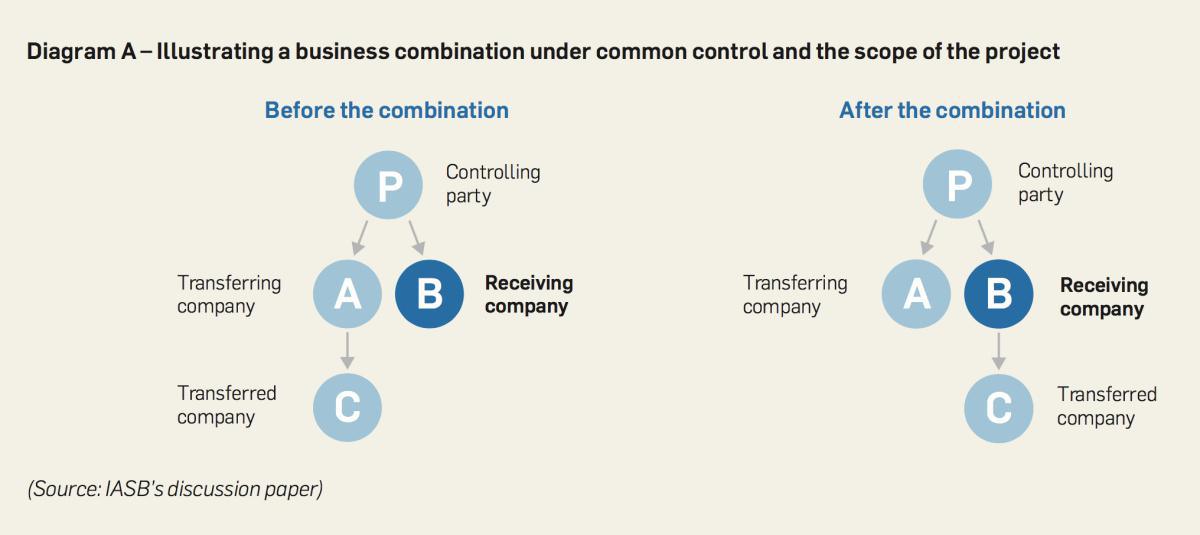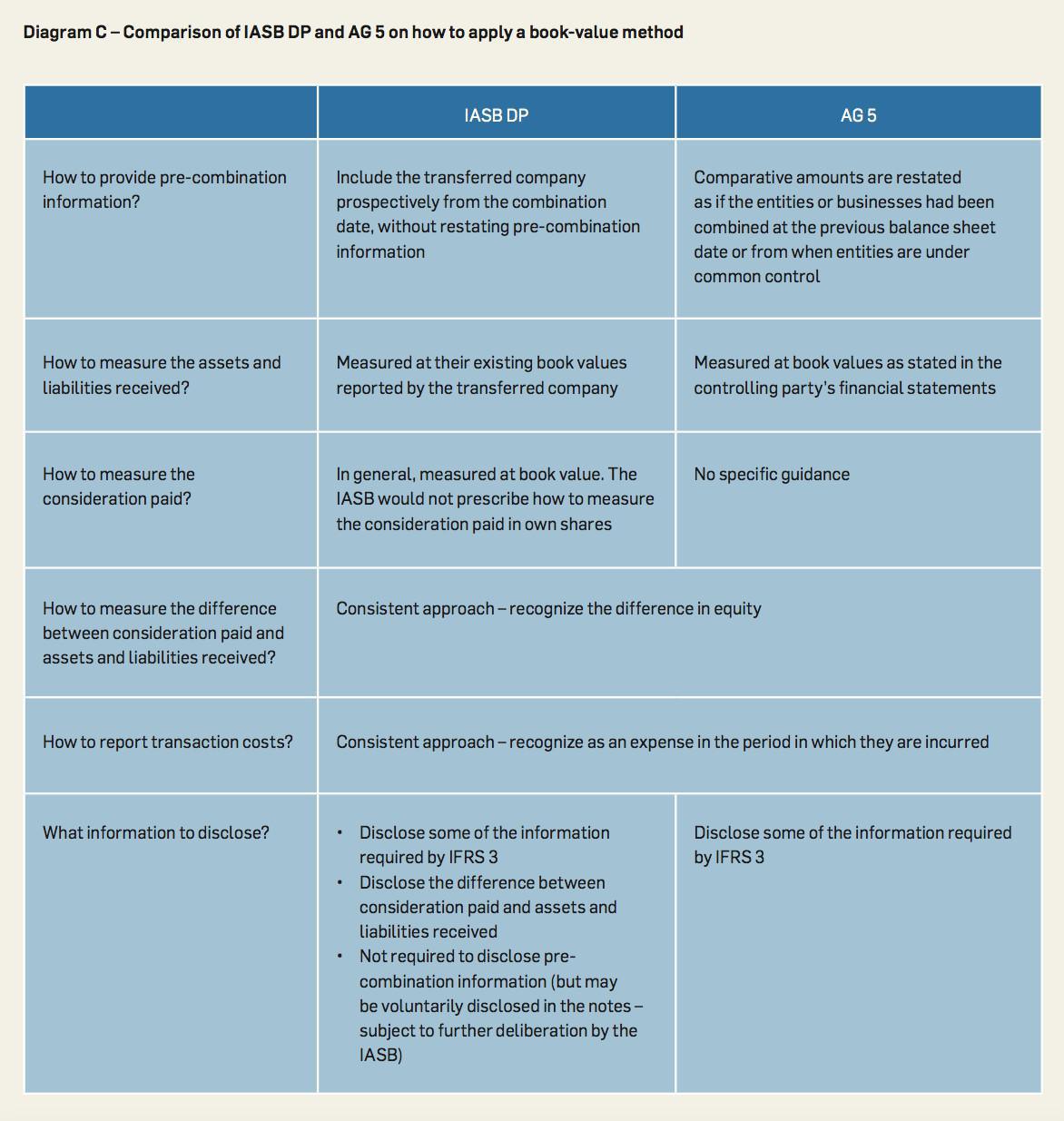Background
Accounting requirements for business combinations – sometimes called mergers and acquisitions – are set out in International Financial Reporting Standard (IFRS) 3 Business Combinations. However, IFRS 3 explicitly scopes out business combinations under common control (BCUCC) – combinations in which all of the combining entities or businesses are ultimately controlled by the same party or parties, both before and after the business combination.
In the absence of a specifically applicable IFRS, companies are required to develop their own accounting policy under International Accounting Standard 8 Accounting Policies, Changes in Accounting Estimates and Errors. This has resulted in differences in how companies report BCUCC. Typically, companies choose either to apply the acquisition method as set out in IFRS3, which measures the assets and liabilities received in the combination at fair value and may result in recognizing goodwill, or a book-value method, which measures assets and liabilities received at their existing book values. In practice, a variety of book-value methods are used, for example the predecessor method, merger accounting and pooling of interests method. Furthermore, companies often provide insufficient disclosures about BCUCC.
The International Accounting Standards Board (IASB) is carrying out a research project to consider filling this gap in the standards to improve the comparability and transparency of reporting these combinations. In late November 2020, the IASB published a discussion paper (DP) that sets out its preliminary views on how to account for BCUCC. The DP is open for public comment until 1 September.
Who will be affected by the DP?
BCUCC are very common in Hong Kong, particularly in companies preparing for a listing and to a certain extent among listed companies. Based on the Institute’s research findings from Common control combinations – How they were reported in Hong Kong available on the Institute’s website, and feedback from stakeholders, a majority of Hong Kong-listed companies and companies preparing for listing accounted for BCUCC using a book-value method, and these companies generally applied the merger accounting following Accounting Guideline (AG) 5 Merger Accounting for Common Control Combinations issued by the Institute, which is non-mandatory guidance that sets out the principles to account for common control combinations.
The IASB’s preliminary views on when to apply the acquisition method or a book-value method, and how to apply the book-value method, are different from the approach under AG 5. If the IASB’s preliminary views are implemented, they may have a significant impact on existing accounting practices in Hong Kong. This could, in turn, affect the receiving company’s financial position and performance, and the information that users of financial statements consider when performing analyses and making investment decisions.
For example, under the proposed book-value method, the pre-combination financial information of the transferred company will not be included in the consolidated financial statements of the receiving company. Companies preparing for a listing may be impacted as the Hong Kong Listing Rules require financial information for a set number of financial periods to be provided in the accountants’ report, yet many group reorganizations are completed shortly before an initial public offering takes place.
What are the IASB’s preliminary views?
(a) Scope of the project
The project is considering all transactions that involve the transfers of a business under common control, including group restructurings that involve the transfer of a business to a newly established parent company. It is not considering transactions that do not involve the transfer of a business, e.g. transfers of assets under common control or transfers of companies that do not constitute a business as defined under IFRS 3.
The project addresses how a receiving company (the company to which control of one or more companies or businesses has been transferred in the combination) should report BCUCC in its consolidated financial statements. It also addresses the reporting of BCUCC in the receiving company’s other types of financial statements (e.g. separate or individual) if the combination involves a transfer of an unincorporated business. This project does not consider reporting by the controlling party, the transferring company or the transferred company because reporting by those parties is already addressed in IFRSs. Diagram A below provides a simple example of BCUCC, the relevant parties, and which party is impacted by the proposals.
(b) When to apply the different measurement methods
In determining how to account for BCUCC, the IASB considered:
- Useful information for users (existing and potential investors, lenders and other creditors) – what information would be useful for the users of the receiving company’s financial statements (the project does not seek to address the controlling party’s information needs);
- Nature of transactions – whether and when BCUCC are similar to business combinations covered in IFRS 3;
- Cost-benefit analysis – whether the benefits of providing particular information would justify the costs of providing it;
- Complexity – how complex particular approaches would be; and
- Accounting arbitrage – whether particular approaches could create opportunities to structure transactions to achieve a particular accounting outcome.
The IASB’s preliminary view is that neither the acquisition method nor a book-value method should be applied to all BCUCC. Diagram B below summarizes the IASB’s preliminary views on how to determine the appropriate measurement method.
In summary, the IASB’s preliminary view is that in principle, the acquisition method should be applied if the BCUCC affects non-controlling shareholders (NCS) of the receiving company. A book-value method should be applied to all other BCUCC, including all combinations between wholly-owned companies.
Taking into account the cost-benefit trade-off and other practical considerations for BCUCC that affect NCS of the receiving company, the IASB suggests that:
- The acquisition method is required if the receiving company’s shares are traded in a public market.
- If a receiving company’s shares are privately-held:
– The receiving company should be permitted to use a book- value method if it has informed all of its NCS that it proposes to use a book-value method and they have not objected (the optional exemption).
– The receiving company should be required to use a book-value method if all of its NCS are related parties of the company (the related-party exception).
(c) How to apply the acquisition method
In the IASB’s view, in principle the acquisition method as set out in IFRS3 should be applied by the receiving company. However, in a BCUCC, the consideration paid might have been directed by the controlling party rather than the receiving company and transferring company, and hence differ from the amount that would have been paid in an arm’s length transaction. Such a difference suggests that the combination includes an additional component that is not present in a combination between unrelated parties. That additional component might represent a distribution from, or a contribution to, the receiving company’s equity.
In relation to this additional component, the IASB’s preliminary views are:
- The receiving company should recognize a contribution to equity if the fair value of the assets and liabilities received exceeds the fair value of consideration paid (instead of recognizing that difference as a gain on a bargain purchase in the statement of profit or loss, as required by IFRS 3).
- The receiving company should not be required to identify, measure and recognize a distribution from equity if the consideration paid exceeds the consideration that would have been negotiated between unrelated parties, because such a distribution could be difficult to identify and measure, and is unlikely to occur in a combination that affects NCS. As such, any “overpayment” that occurs in BCUCC that affects NCS would initially be included in goodwill and subsequently be tested for impairment just like the current accounting for goodwill.
- The receiving company should disclose information about the terms of the combination, including how the transaction price was set.
(d) How to apply a book-value method
Current IFRSs do not describe a book-value method and, as discussed above a variety of methods are used. To reduce that diversity and improve comparability, the IASB’s view is that IFRSs should prescribe a single method. Diagram C below summarizes the IASB’s preliminary views on how to apply a book value method and compares those views against the merger accounting under AG 5.
Act now!
The Institute is holding a roundtable discussion on 11 May (via Zoom or in person) on the topic. Visit the website for more details. We strongly encourage interested parties to join and express their views directly to the IASB board members and staff in attendance. You can also express your views through a meeting with the Standard Setting Department or by sending a comment letter. Contact commentletter@hkicpa.org.hk.
Take part so we can help steer the IASB in developing accounting requirements for BCUCC that are fit for purpose for the Hong Kong market. Also visit the Institute’s BCUCC webpage for more useful resources.
This article is contributed by the Institute’s Standard Setting Department.



















